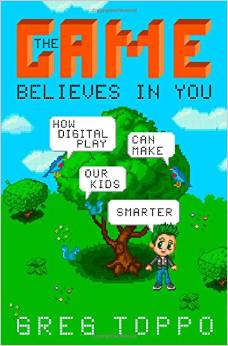Can Games Really Make Kids Smarter?
The Game Believes in You: How Games Can Make Our Kids Smarter
By Greg Toppo
(Palgrave/MacMillan, 2015 – Learn more)

Greg Toppo set off on a sort of walkabout of schools, with a question in mind that should be familiar to any teacher with a classroom of students: How are games transforming learning in educational circles?
This question then morphed into an ancillary inquiry for Toppo, a journalist for USA Today and a former teacher, as he thought more about reading and writing in the digital age: What are kids paying attention to these days?

The possibility for individualized and differentiated learning
The title of Toppo’s book – The Game Believes in You – encapsulates the idea that a well-designed game immerses the player in a unique experience that requires us to adapt to the rules of the game environment, deeply understand contextual clues, take advantage of collaboration possibilities, and engage in critical thinking that pushes the player beyond his or her comfort zone.
Done well, a game takes what teachers can do in the classroom and moves it to another level that is both individualized and differentiated.
Notice how I have not yet used the phrase “video game” here. That is important and intentional. As Toppo notes, while video gaming has certainly emerged as a pop culture phenomenon with the rise of mobile devices and advanced gaming consoles (and in the near future, virtual reality helmets), there is a broader concept of gaming that incorporates video games and gamification of the classroom setting itself. (Gamification is the idea of using rewards and challenges as part of regular classroom instruction, centered on inquiry.)
A close look at games across the country
Toppo shows the readers of his book an interesting project in which a team at the University of Southern California is adapting Thoreau’s Walden for an immersive reading experience in the age of virtual reality. Then there’s the high school civics teacher who uses elements of fantasy sports gaming to teach students about global political affairs. At the Quest to Learn school in New York City, game inquiry and challenge projects are fully blended and baked into the curriculum. Toppo also visits a classroom teacher who uses World of Warcraft (and who has tinkered with Second Life) to teach the Humanities to her students.
The intersection of games and learning
Toppo asks some critical questions that we all should ask as we approach gamification: Is this shift into gaming even a good idea for learning environments? Or does it just lead to distraction? How do we measure the progress of learning when we use gaming?
I think Toppo would likely agree with my answer: If the game pushes the learner beyond the traditional learning experience, then gaming is a great concept, with many possibilities. However, if the idea of gaming is merely to have students play an online game that reinforces a lesson already taught, then I am not all that convinced this experience is transformative.
Toppo does bring us into an elementary school in Washington DC that is using an online video game math system to boost students’ experience and confidence with math concepts. The project has boosted math proficiency scores on standardized testing. I won’t argue with the increase in scores, but I am not fully convinced that this kind of gaming environment, with its penguin mascot known as JiJi and its tracking of student progress, is quite the advancement in gaming that Toppo suggests.
From player to creator?
While Toppo covers a lot of ground here, and he does it well as a talented journalist, I would personally like to see more about teaching game design to students directly, so that they make their own games instead of playing the games of others. Many online games are profit-making enterprises, with advertising that we should all be wary of exposing our students to. Even expensive educational games can sacrifice pedagogical value in favor of surface-level engagement.
Toppo explained to me via Twitter that this particular element of gamification – students as game designers — was not a focus for this book, and I don’t fault him for this exclusion. But I would argue that, as we consider how best to put the tools of inquiry and creation into the hands of our students, transforming them from players to designers might make a lot of sense. If so, then explicit teaching of game design has a role in the classroom.
Toppo emerges from his walkabout (my term, not his) with a better understanding of how gaming can positively impact learning, if done well. He is smart to address concerns about violence in video games in a late chapter. He also provides an insightful chapter for parents and educators about how to talk with young people about the world of gaming, framing the conversation in a very positive light and noting that adults have an important role as filter and mentor.
I’ll leave you with a reflection point from Toppo at the end of The Game Believes in You that I think captures his findings:
Reporting this book, I often felt a bit of despair for our educational system. It often seems designed by the people for whom school was easy, who have always done what they are told. In spite of this – or perhaps because of it – the system seems to mess up everything it touches, even great ideas. But each time I sat down to watch a child work, I came away more hopeful. Again and again, I was reminded of one key fact: young people are naturally, unpredictably creative and resilient, and most of the time they are merely tolerating our input. They live inside the magic circle and know how powerful it is.” – Greg Toppo, The Game Believes in You, page 221.
Kevin Hodgson is a sixth grade teacher in Southampton, Massachusetts, and is the technology liaison with the Western Massachusetts Writing Project. Kevin blogs regularly at Kevin’s Meandering Mind and tweets more often than is healthy under his @dogtrax handle.






























